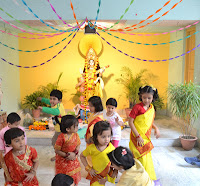‘Ashche bochor abar hobe’ is the popular refrain that echoes
throughout during any bishorjon/immersion.
With this cry, one is always filled with pain and sorrow. The much-awaited
festival has finally come to an end. And with it ends our fun and frolic. Time
to get back to studies or the daily grind whichever is applicable to one.
But with Saraswati Pujo despite the gloominess, there has
always been something to look forward to. The next day after Saraswati Pujo is
equally important. This day is popular amongst us as Shitol Shoshthi/Gota Sheddho.
Shitol means cold
in Bengali and Shoshthi is the deity
we worship for the well-being of our children or better known as the Goddess of
Fertility. Shitol Shoshthi for any Bangali is a strictly no-cooking day.
Yes, you’ve got it right. We don’t cook that day, in fact as Dadima (my maternal grandmother) and Ma
pointed out they were not supposed to light the unoon (the earthen stoves) on that particular day. Food had to be
cooked on the day of Saraswati Pujo which was then served cold the next day.
Hence the term Shitol Shoshthi.
 |
| The Panch Kalai out in the sun |
So what do we eat that day? The menu for the day comprises
of Gota Sheddho. Gota implies whole and Sheddho
is boiled. Gota Sheddho comprises of Panch Kalai (five kinds of dal) and three/five/seven kinds of vegetables. This
fascination with odd numbers (bijor
shonkha), I have to find out from my elders the rationale behind it. Even
numbers are a strict NO. Therefore if one doesn’t want to add three kinds of
vegetables then it has to be five or seven. The pulses are roasted and then
soaked overnight. Kul and sweet potato
is a MUST in our family. One can also add shelled peas, brinjals, and potatoes.
But all these vegetables should have their bota,
I mean the stem. Hope now you realize why this concept of ‘gota’.
 |
| My dekchi for Gota Sheddho |
Gota Sheddho is
prepared keeping in mind the number of family members. I have three sisters and
we are all scattered across the country. When Ma makes Gota Sheddho she puts in vegetables for each of her daughters, her
sons-in-law and her grandchildren irrespective of the fact that they might not
be in town. So if she has three kinds of vegetables then she has to put in three
for each and every family member. Such is the ritual. This ritual is for the
well-being of her children. I still remember the huge dekchi (pan) that she used for the ritual. The aluminum had turned
into black after years of boiling Gota
Sheddho. First the kalai would go
in followed by the vegetables. It would
take some 3-4 hours to boil. No salt, ghee, turmeric would be added into
it.
This ritual is usually performed by the matriarch of the
family. In our case it was my grandmother and then Ma taking it up. But first
she has to take a bath, purify herself and then wrap the shil-nora (the grinding stone) in a yellow cloth and worship it
with holud, shidur and mustard oil.
Only then can the making of Gota Sheddho commence.
After the Puja the holud is then
applied as a teeka on everyone’s
forehead.
Gota Sheddho is
served cold. Heating it is ruled out. Add salt, mustard oil and green chilly
and it tastes wonderful. It tastes good, it’s good for health and yes my
grandmother keeps on reiterating that it is ‘anti-pox’. That’s what they
believe in. During my grandmother’s times there were no vaccines. Mortality
rate was high as many children died due to pox. Gota Sheddho is considered a natural, yearly vaccine against pox.
 |
| Roasted and soaked..ready for the boil |
In my family I have seen that it’s not just Gota Sheddho we make. Ma and Dadima spend hours in the kitchen cooking up a
storm. Shojnefuler jhal, ilish macher jhal, postor bora, Macher tok
are a must for us.
Gota Sheddho was a
huge family affair at our maternal grandparents’ house in Asansol. Dadima’s dekchi had ingredients for
some fifteen family members besides the domestic help. And there would be neighbors
who would be invited for lunch. Some would send their four-storey Tiffin
carriers. Quite a sight it was. The
kitchen in our sprawling Asansol house was separate and was built in the
Assamese style with a sloping tiled roof. It was two-roomed kitchen with two
huge unoon. We would all line up on
the verandah to have Gota Sheddho.
The whole family together, laughter, shouts and giggles, it was an impressive
affair.
 |
| The kitchen at Asansol. It was demolished in 2010. |
My husband is a bangal
which means he comes from Opar Bangla
or in better words from East Bengal. This ritual was alien to them. I
introduced this custom and since then I have tried my best in continuing with
it. This year is the first time that I couldn’t make Gota Sheddho at home. New in Orissa, I couldn’t locate vegetables
with bota, no Ilish available and no shojneful.
But next year I am determined to make Gota
Sheddho even if it means importing all the ingredient s from Kolkata.
Such is my love for Gota
Sheddho!







